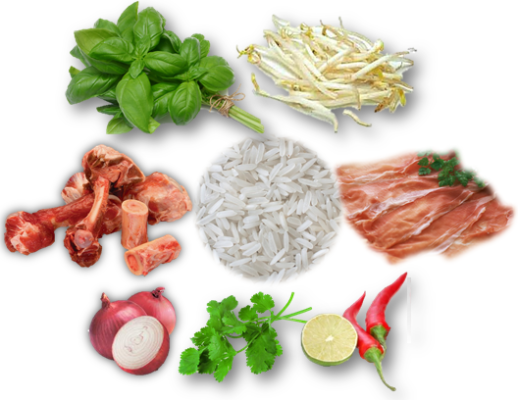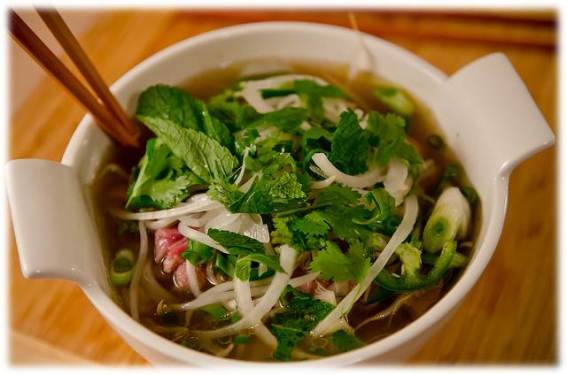Arguably, pho has become the representation of Vietnamese cuisine. Perhaps it is less confusing for many Americans if naming pho as “beef soup rice noodle”. However, it is just pho – the name makes the exoticism apparent.
In fact, the origin of Pho is also exotic. It is believed that rice noodles were brought by Chinese (Cantonese) immigrants. There are also people claiming that the noodle soup was influenced by French cuisine, although such claim is disputed by many others. (Visit http://vietworldkitchen.typepad.com/blog/2008/10/the-evolution-of-pho.html to read more about the arguments.)
So, what are there in this bowl of soup noodle? In fact, some of the ingredients for making Pho are familiar to Americans (possibly due to the influence of French cuisine on pho). The image below shows eight basic ingredients.
 Although there are variety types of Pho, the basic ingredients remain the same. Beef plays an important role in this dish. The broth is typically made by beef bone. Sliced beef, raw or cooked, is put on top of the noodles. Other than beef, onion, basil, lime and pepper are also common in western cuisine. Using “normal” ingredients is arguably one of the reasons for pho being accepted in America.
Although there are variety types of Pho, the basic ingredients remain the same. Beef plays an important role in this dish. The broth is typically made by beef bone. Sliced beef, raw or cooked, is put on top of the noodles. Other than beef, onion, basil, lime and pepper are also common in western cuisine. Using “normal” ingredients is arguably one of the reasons for pho being accepted in America.As Vietnamese emigrants settled over the U.S, pho became rather common. To adapt to American market, pho undergoes many changes. Historically, since “good beef” is luxurious in Vietnam, there are also chicken pho and pork pho; furthermore, tripe and chick giblets are saved to make the soup together with beef bones. However, the wealth and cheap beef of America allows Pho to modify: the broth is prepared by “edible” ingredients only (no tribes and giblets); customers can also personalize their bowls by choosing from having beef, tendon, tripe, meatballs, chicken, seafood, etc. Moreover, the serving of pho in America is significantly bigger than that in Vietnam, which is another sign of localization due to food abundance. (Visit http://vietworldkitchen.typepad.com/blog/2008/10/the-evolution-of-pho.html for more information)
A bowl of pho is a balanced meal. There are vegetables (bean sprouts, cilantro, onion, green onion, basil, pepper), protein (beef, chicken, or pork), and carbonhydrate (rice noodle) in it. However, the extra-large size with the over-abundant garnish of beef make pho an Americanized Vietnamese food. It is still exotic, for the using of rice noodle and cilantro; but its exoticism is localized, meaning that part of its charisma remains hidden in the history and culture of Vietnam.
[Source of Images: Internet (Edited by author). Sources of information and further readings: http://goseasia.about.com/od/vietnamesepeopleculture/a/pho_noodles_vietnam.htm


I feel like once food is Americanized, it becomes less healthy. The problem is not the food itself but the way that food is cooked and prepared. For example, food, as long as it can be fried, is fried. French steamed cod can be fried; Japanese sushi can be fired (I tried once in an Asian restaurants here); even Chinese wonton can be fried! The really problem of fried food is that too much oil is absorbed when food is fried, which leads to cardiovascular diseases when we eat fried food. Another problem about American food is that there is always so much sugar or salt added to the dish. I was astonished when I heard that America was actually the world’s largest sugar consumer in the world. American food is also usually associated with oversized package, making people eat more than they should since the capacity of people’s stomach is very elastic.
Thank you Yvonne, for the great comment! Having travelled to many countries and continents, I have surely noticed the things that you mentioned in the comment. I feel that the proportion of unhealthy food, say fried, salted, and sweetened food, in typical American diet is amazingly large than that of many different diets, namely French, Japanese, and Chinese. This phenomena appears to be weird to me. Most people have the unpleasant experiences of eating too much or too oily; however, a food culture that serves to keep people from having those experience does not seem to have established in America and I wonder why.